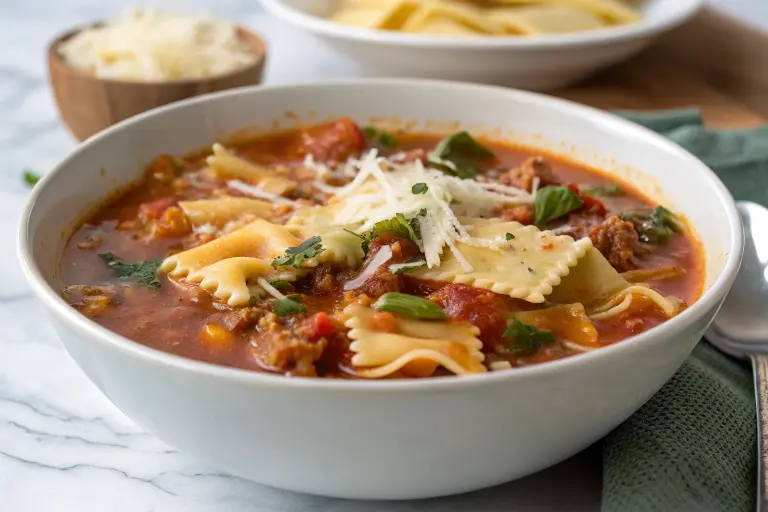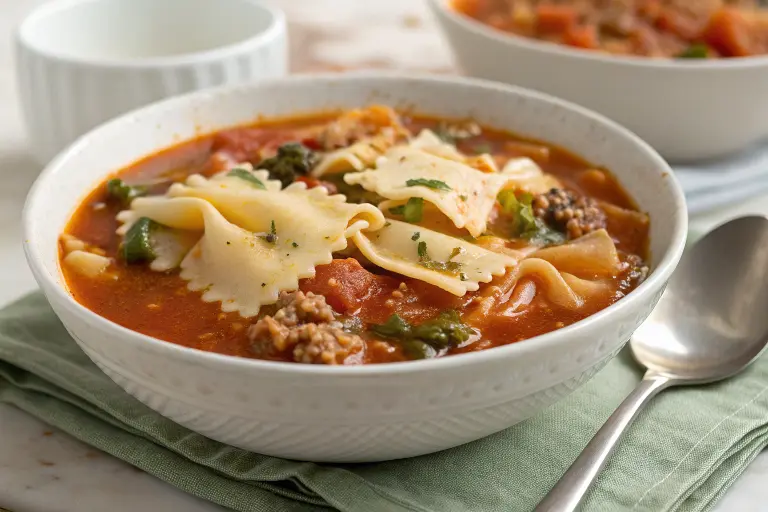Lasagna is a beloved dish that brings warmth and comfort to any meal, whether it’s a family dinner or a festive gathering. However, one of the most common frustrations when preparing lasagna is ending up with a soupy, watery texture. If you’ve ever wondered what makes lasagna soupy and how to prevent it, you’re not alone. This issue can occur for various reasons, but with a little knowledge and some simple steps, you can avoid it and create the perfect, layered masterpiece.
So, what makes lasagna soupy? It’s not just about too much sauce or overly wet ingredients and several factors contribute to this problem. In this article, we will walk you through the causes of a soupy lasagna and provide actionable tips to ensure your dish comes out thick, rich, and satisfying. Whether you’re a seasoned chef or a beginner, understanding what makes lasagna soupy and how to manage moisture will help you perfect your recipe and impress your guests with every bite.
Let’s dive into the details, uncover the secrets behind this common problem, and discover how to prevent it in your next lasagna!
Why Does Lasagna Get Soupy?
Lasagna can turn soupy for a number of reasons. Understanding what makes lasagna soupy can help you identify and solve the problem before it happens.
Excessive Moisture from Ingredients
One of the most common causes of soupy lasagna is the moisture content of the ingredients. For instance, ingredients like tomato sauce, ricotta cheese, and even vegetables such as zucchini and mushrooms release a lot of water when cooked. If these ingredients are not properly prepared, they can release too much liquid, causing your lasagna to become soupy.
Overcooked Noodles
If you cook your noodles too long before assembling your lasagna, they can absorb more moisture than they should. This leads to soggy noodles, which can cause the entire dish to become watery.
Insufficient Layering and Drainage
Proper layering is crucial for lasagna. If the layers aren’t arranged in a way that allows the liquid to drain off, the sauce and juices from the filling will accumulate and make the lasagna soupy. A lack of proper drainage between layers can contribute to the watery consistency.
Not Allowing the Lasagna to Rest
Many people cut into their lasagna right after taking it out of the oven. However, letting the dish rest for a few minutes allows the ingredients to set. This resting period helps the sauce and cheese firm up, giving you a thicker, more structured lasagna.

How to Fix Soupy Lasagna
Now that we know the main factors contributing to soupy lasagna, let’s dive into how to prevent or fix this issue.
1. Drain Your Ingredients
The first step in avoiding a soupy lasagna is properly draining any wet ingredients before assembling the dish. For example, if you’re using canned tomato sauce, make sure to drain any excess liquid. Similarly, if you’re using ricotta cheese, you can strain it to remove extra moisture.
- Tip: You can also roast vegetables like zucchini or mushrooms to remove excess water before adding them to the lasagna.
2. Par-Cook Your Noodles
Instead of fully cooking your noodles, consider par-cooking them. Par-cooking means boiling the noodles for only a few minutes until they’re slightly tender but firm. This step ensures that the noodles won’t absorb too much sauce and will hold their shape in the final dish.
3. Use a Thicker Sauce
A thin, runny sauce is a primary cause of soupy lasagna. Make sure your tomato sauce is thick enough to coat the noodles and other layers. You can achieve this by simmering the sauce longer to reduce excess liquid or adding ingredients like tomato paste for a thicker consistency.
4. Layer Properly
The way you layer your lasagna can also affect its consistency. Make sure to spread each layer evenly without overloading it with sauce. Use just enough sauce to coat each layer of noodles, but don’t let it pool.
5. Let Your Lasagna Rest
After you’ve finished baking your lasagna, let it rest for 10-15 minutes before cutting into it. This resting time allows the sauce to settle, and the dish will firm up, reducing the chances of a soupy lasagna.
How to Make Your Lasagna the Right Consistency
Now that you know what makes lasagna soupy and how to avoid it, it’s important to understand how to get your lasagna to the perfect consistency.
1. Control the Sauce-to-Noodle Ratio
A key part of getting the right texture is balancing the sauce-to-noodle ratio. If you use too much sauce, your lasagna will be watery, but if you use too little, it will be dry. Aim for an even amount of sauce to ensure the noodles absorb just enough liquid without becoming soggy.
2. Use Ricotta Wisely
Ricotta is a staple in lasagna, but it can add moisture. Drain the ricotta well before using it to prevent it from making your lasagna soupy. If needed, you can mix the ricotta with a beaten egg to help it set and firm up during baking.
3. Opt for Thicker Meat Sauce
If you’re making a meat sauce for your lasagna, cook it down to a thicker consistency. This allows the sauce to hold its shape better and prevents it from leaking into the noodles too much. Also, avoid adding too much water or stock during the cooking process.
4. Avoid Overfilling
When assembling your lasagna, avoid overfilling it with too many ingredients. This can lead to uneven cooking and excess moisture. Stick to a balanced ratio of noodles, sauce, cheese, and meat to maintain the proper consistency.
What Makes Lasagna Soupy? Understanding the Role of Cheese
Cheese is an essential component of lasagna, but it can also contribute to a soupy texture if not managed properly. The high moisture content in cheeses like mozzarella and ricotta can make your lasagna watery, especially if you use too much.
1. Use Less Moisture-Rich Cheese
Instead of using a lot of fresh mozzarella, which can release excess water, try using part-skim mozzarella, which has less moisture. You can also mix in Parmesan cheese, adding richness without the added moisture.
2. Dry Your Cheese
If you’re using fresh mozzarella, make sure to pat it dry with paper towels before adding it to the lasagna. This simple step can significantly reduce the amount of water it releases during baking.
3. Bake at the Right Temperature
Lasagna needs to bake at a consistent temperature for the cheese and sauce to set properly. Baking it at too low a temperature can cause the cheese to remain too soft, while baking it at too high a temperature can dry out the sauce and cheese, making it uneven.
Common Mistakes That Make Lasagna Soupy
There are several mistakes that can contribute to a soupy lasagna. Let’s take a look at some of the most common ones.
1. Not Preheating the Oven
When you bake lasagna, preheating your oven is essential. If you place the lasagna in an oven that isn’t hot enough, the cooking process can become uneven, and excess moisture might not evaporate as it should.
2. Using Watery Vegetables
Vegetables like zucchini, spinach, and mushrooms release moisture as they cook. If you don’t prepare them correctly, such as by draining or roasting them before adding them to the lasagna, this moisture can make your lasagna soupy.
3. Not Using a Wide Baking Dish
Using a small, crowded baking dish can trap steam and moisture inside, causing your lasagna to become soupy. A larger dish allows for better heat circulation and ensures the layers cook more evenly.
4. Skipping the Resting Time
As mentioned earlier, skipping the resting period after baking is one of the quickest ways to ruin your lasagna’s texture. Allow it to rest so the ingredients can firm up, making a cleaner cut when you serve it.

FAQs: What Makes Lasagna Soupy?
❓ What causes lasagna to be runny?
Lasagna becomes runny due to excessive moisture from ingredients like tomato sauce, ricotta cheese, watery vegetables, and overcooked noodles that absorb too much liquid.
❓ How to prevent lasagna from being too soupy?
To prevent soupy lasagna, drain excess moisture from ingredients, use a thicker sauce, and allow the lasagna to rest after baking to let the liquid settle.
❓ Is lasagna supposed to be soupy?
No, lasagna should not be soupy. It should have a thick, rich consistency with well-set layers of sauce, noodles, and cheese.
❓ How to make lasagna sauce less watery?
To make your lasagna sauce less watery, simmer it longer to reduce the liquid, or add tomato paste to thicken it. You can also use less watery cheese and vegetables.
Conclusion: What Makes Lasagna Soupy?
In conclusion, understanding what makes lasagna soupy and knowing how to prevent it is crucial for creating a perfect, satisfying dish. By following the strategies outlined in this article, such as draining your ingredients properly, using a thicker sauce, layering carefully, and allowing your lasagna to rest, you can ensure that your lasagna retains its structure and flavor without becoming watery. With these tips in hand, you’ll be able to avoid the common pitfalls and enjoy a beautifully layered lasagna that is as rich and hearty as it should be.
If you like comfort foods like lasagna, you might also enjoy exploring other hearty recipes on Chaynez Recipes. For instance, our Chicken Alfredo Soup with Beef and Parmesan Cheese is a creamy, flavorful dish combining two classic comfort foods. Or, if you’re looking for something light and comforting, try our Alfredo Chicken Noodle Soup, a deliciously rich soup perfect for chilly evenings.
For even more recipe inspiration and culinary tips, feel free to visit our Chaynez Recipes platforms, where you can find all our latest dishes and cooking guides. Happy cooking, and here’s to the perfect lasagna every time!






